When choosing a portable camping grill, you’ll want to allocate 72 square inches of cooking space per camper and prioritize models weighing 10-50 pounds for manageable transport. Consider gas grills for convenience and precise temperature control, or charcoal for superior smoky flavor and high-heat searing capabilities. Budget $50-$100 for occasional use or invest in premium models for frequent camping. Look for stainless steel construction, reliable safety features, and easy assembly designs that’ll enhance your outdoor cooking experience.
Consider Your Group Size and Cooking Space Requirements
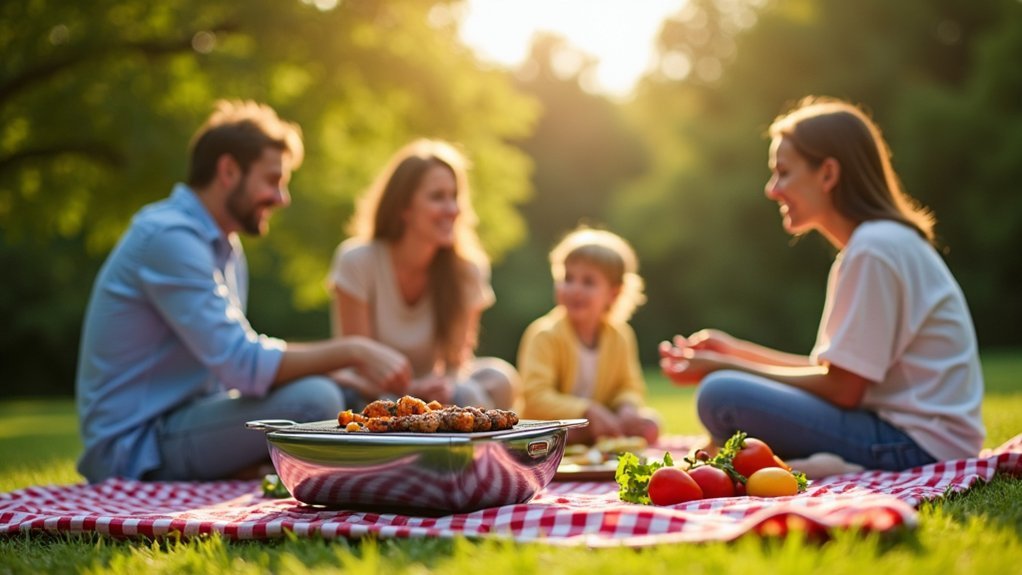
When choosing a portable camping grill, you’ll need to match the cooking space to your group size to guarantee everyone gets fed efficiently.
Plan for approximately 72 square inches per person when calculating your requirements. For couples, grills offering 100-150 square inches work perfectly, while larger groups need 300+ square inches of cooking area.
Allocate 72 square inches per camper: couples need 100-150 square inches, while groups of four require 300+ square inches minimum.
Consider models like the Weber Smokey Joe with 147 square inches for intimate gatherings of 1-2 people.
However, if you’re cooking for four or more campers, you’ll want something like the Weber Traveler’s 320 square inches, which lets you grill multiple items simultaneously.
Remember that portable grills range from 10-50 pounds, so balance your group size needs with transportability.
Compact options limit meal variety but offer easier transport for smaller adventures.
Evaluate Weight and Portability Features for Easy Transport
Since you’ll be carrying your grill to various campsites, weight becomes a crucial factor that can make or break your outdoor cooking experience.
When evaluating portable camping grills, you’ll want to balance cooking capacity with easy transport capabilities.
Consider these essential portability factors:
- Optimal weight range – Choose models between 10-50 pounds for manageable transport without sacrificing functionality.
- Built-in mobility features – Look for grills with sturdy handles and wheels that enhance portability during movement.
- Ultra-lightweight options – Consider featherweight models like the Weber Smokey Joe (9.5 pounds) when portability trumps cooking space.
- Compact design – Evaluate collapsible or space-efficient designs that fit easily within your RV or vehicle storage.
Grills around 50 pounds remain manageable for one or two people while providing adequate cooking capacity.
Choose Between Gas and Charcoal Based on Your Grilling Style
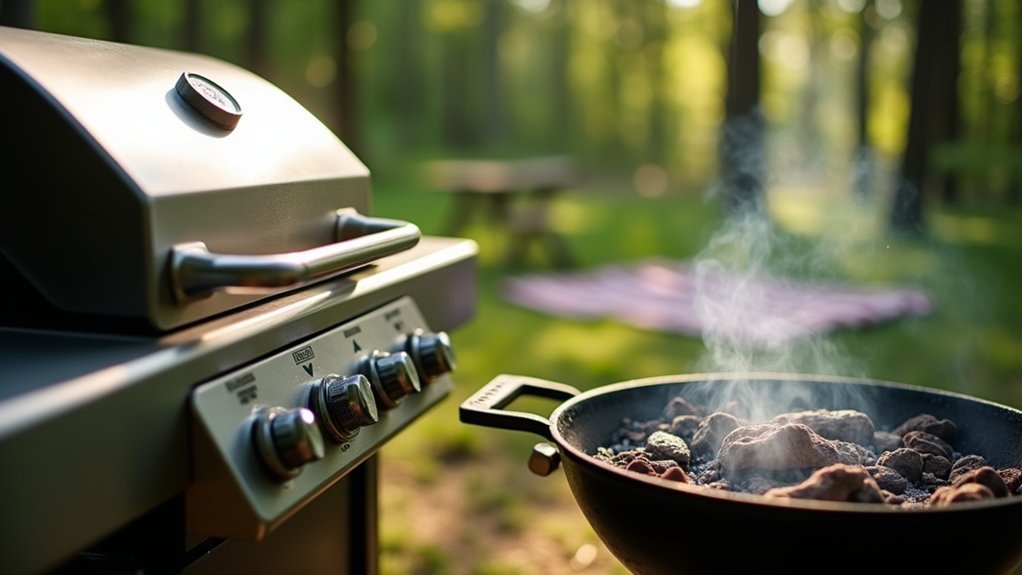
How do you decide between the convenience of gas and the authentic flavor of charcoal for your camping adventures?
Gas grills offer unmatched user-friendliness with quick ignition and precise temperature control through simple propane hook-up, perfect for spontaneous trips. However, charcoal grills deliver superior smoky flavor and better browning that enhances your grilling experience, though they require more time to light and maintain.
Consider your cooking priorities: charcoal grills excel at high-heat searing due to their ability to reach higher temperatures, while gas grills may struggle with intense heat.
Factor in cleanup preferences too—gas grills provide easier maintenance without ash disposal hassles.
Your choice ultimately depends on whether you prioritize convenience and quick setup or authentic flavor and superior cooking performance during your camping adventures.
Set a Realistic Budget That Matches Your Usage Frequency
Your camping frequency should directly influence how much you’re willing to spend on a portable grill.
If you’re an occasional camper who hits the trails a few times per year, a budget-friendly option in the $50 to $100 range will likely meet your needs without breaking the bank.
However, if you’re a regular outdoor enthusiast who camps monthly or more, investing in a higher-end model makes financial sense since you’ll get more value from the enhanced durability and features over time.
Occasional Vs Regular Use
When determining your portable camping grill budget, you’ll want to match your spending with how often you actually plan to fire up the grill. Your usage frequency directly impacts which features matter most and how much you should invest.
Occasional vs Regular Use Considerations:
- Occasional use calls for budget-friendly options like the Weber Smokey Joe ($55) that prioritize portability and basic functionality over advanced features.
- Regular grilling enthusiasts benefit from investing in higher-end models like the Nomad Grill & Smoker, which offer superior durability and cooking performance.
- Features should align with frequency—occasional users need compactness and easy transport, while regular users want larger cooking areas and advanced heat control.
- Long-term value favors quality investments for frequent campers who grill multiple times per season.
Price Range Considerations
Smart budgeting transforms your portable camping grill search from overwhelming to strategic. Price range considerations should align with your camping frequency and specific needs.
You’ll find affordable options like the Weber Smokey Joe starting around $50, perfect for occasional use. However, if you’re a frequent camper, investing in higher-end models exceeding $300 offers better durability and extended warranties up to 20 years.
Budget-friendly models work well for infrequent trips, but don’t compromise on essential features you actually need.
Consider your group size when evaluating cooking space requirements, as larger grills command higher prices. Remember to factor in ongoing costs like propane canisters ($3-$5 each) and necessary accessories.
Your portable camping grill investment should match your usage patterns rather than stretching beyond practical needs.
Look for Essential Safety Features and Heat Control Options
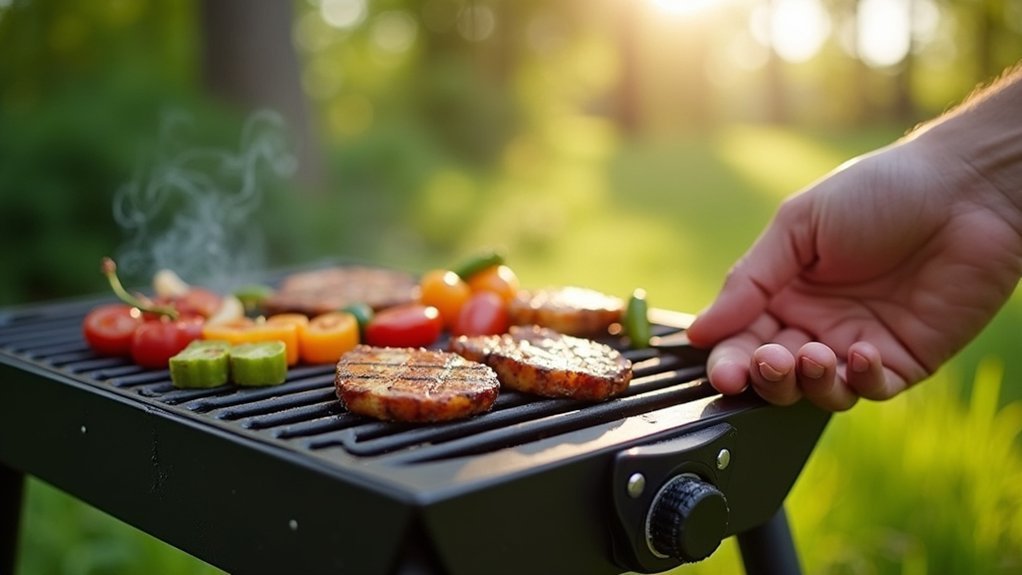
When you’re selecting a portable camping grill, you’ll want to prioritize models with reliable temperature control mechanisms that let you adjust heat levels for different cooking needs.
Safety lock features should be non-negotiable, as they prevent accidental ignition and keep gas valves secure during transport and storage.
These essential components work together to guarantee you can cook confidently while minimizing risks in outdoor environments.
Temperature Control Mechanisms
Since proper temperature control can make the difference between perfectly grilled food and a charred disaster, you’ll want to prioritize grills with robust heat management features.
Effective temperature control mechanisms guarantee consistent cooking results while preventing safety hazards.
Key temperature control features to seek include:
- Built-in thermometers – Monitor cooking temperatures easily without guesswork, guaranteeing food safety and proper doneness.
- Multiple burners on propane grills – Create different heat zones for versatile cooking methods and better temperature management.
- Adjustable air vents on charcoal models – Control airflow to regulate heat levels throughout your cooking session.
- Heat diffusers – Distribute heat evenly across the cooking surface, eliminating hot spots that cause uneven results.
These mechanisms work together to give you precise control over your portable camping grill’s performance.
Safety Lock Features
Temperature control works hand-in-hand with safety features to create a secure grilling environment.
When choosing your portable camping grill, prioritize safety lock features that secure the lid during transport, preventing accidental openings and messy spills in your vehicle or gear bag.
Look for grills with a stable base design that won’t wobble on uneven surfaces. Leg locks are essential safety mechanisms that prevent dangerous tipping while you’re cooking.
You’ll also want built-in flame guards or heat shields that protect you from burns and create safer cooking conditions.
Consider models with automatic ignition systems that eliminate manual lighting risks and reduce flare-up potential.
These safety mechanisms work together to guarantee your outdoor cooking experience remains enjoyable and accident-free.
Assess Fuel Requirements and Availability at Your Destinations
How will you keep your portable grill running throughout your camping trip? Understanding fuel requirements and availability at your destinations is essential for successful outdoor cooking.
You’ll need to decide between propane for convenience or charcoal grills for that authentic smoky flavor.
Here’s what you should consider:
- Check park regulations – Some camping areas restrict charcoal grills due to fire hazards, so verify rules beforehand.
- Research fuel availability – Propane tanks are available at most outdoor retailers, while charcoal is sold at grocery stores and camping supply shops.
- Consider dual-fuel options – These grills accommodate both propane and charcoal, giving you flexibility based on local availability.
- Pack backup fuel – Always bring extra, especially when camping in remote locations with limited supply sources.
Check Construction Materials for Durability and Weather Resistance
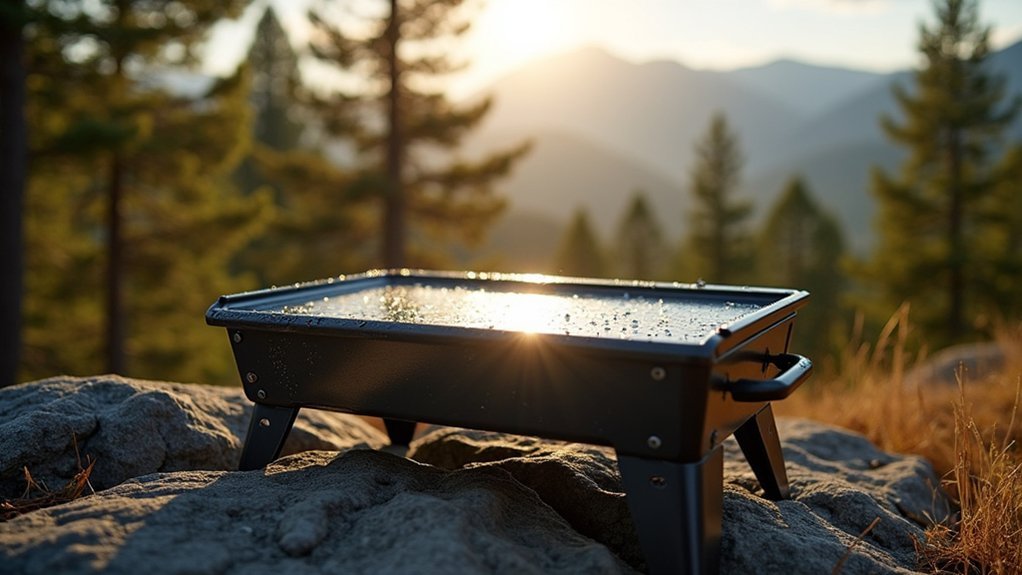
Construction materials determine whether your portable camping grill will survive countless outdoor adventures or fall apart after a few trips.
You’ll want to prioritize stainless steel or aluminum for excellent durability and weather resistance against outdoor elements. Enamel-coated steel offers another solid choice, balancing strength with easy cleaning capabilities.
Focus on materials with effective heat retention properties—thicker construction holds heat better for consistent cooking results.
Thicker grill construction delivers superior heat retention, ensuring your meals cook evenly every time you fire up the grill.
Cast aluminum provides an ideal combination of lightweight portability and sturdy durability, perfect for camping trips where weight matters.
Don’t overlook plastic components like handles and knobs.
Verify they’re high-quality and heat-resistant to prevent degradation from high temperatures and UV exposure.
These details separate grills that last for years from those that disappoint after minimal use.
Examine Cleaning and Maintenance Requirements
While a durable grill matters, you’ll also need to contemplate how easily you can clean and maintain your portable camping grill between adventures. Different grill types require varying levels of upkeep, so understanding these requirements helps you make an informed choice.
Consider these essential cleaning and maintenance factors:
- Look for removable drip trays – These simplify cleaning and prevent dangerous grease flare-ups during cooking sessions.
- Choose non-stick surfaces – They make food release easier and reduce scrubbing time after meals.
- Plan for immediate grate cleaning – Brush grates right after cooking to maintain performance and prevent rust formation.
- Consider charcoal grills’ extra maintenance – They require safe ash disposal to avoid attracting wildlife and comply with camping regulations.
Always check manufacturer guidelines for specific maintenance schedules.
Review Assembly and Setup Complexity for Camp Conditions
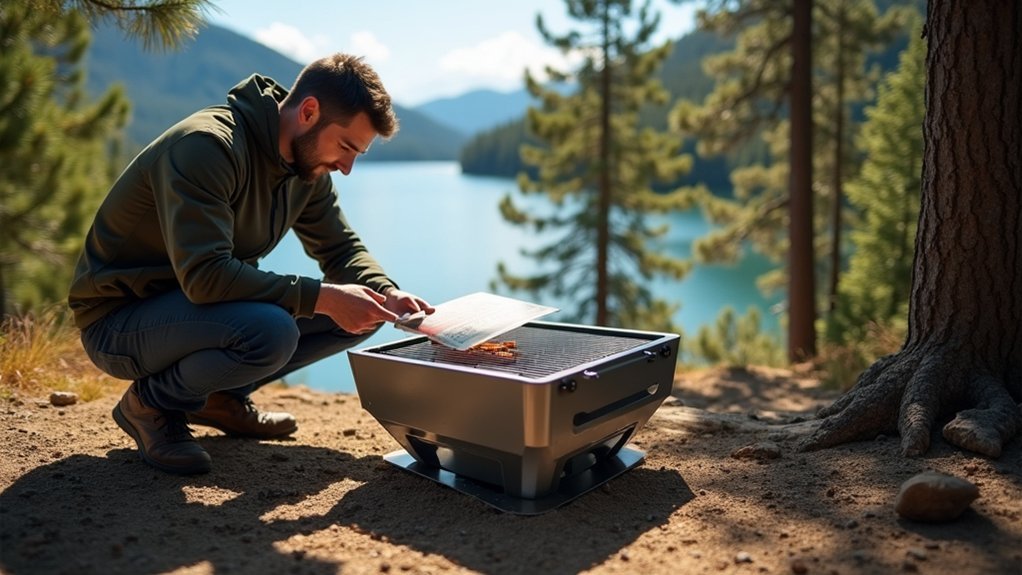
Beyond keeping your grill clean, you’ll want to contemplate how quickly and easily you can get it operational at your campsite. Assembly complexity can make or break your camping experience, especially when weather conditions change rapidly.
| Feature | Recommended | Avoid |
|---|---|---|
| Assembly Time | Pre-assembled components, quick-connect features | Complex multi-step processes |
| Portability Design | Lightweight, collapsible with locking mechanisms | Heavy models requiring tools |
| Setup Process | Simple unfold or straightforward assembly | Multiple loose parts |
Choose grills with minimal assembly requirements and straightforward setup processes. Lighter models enhance portability while collapsible designs with simple locking mechanisms allow quick deployment and breakdown. Always check user reviews specifically mentioning assembly experiences in real camping environments, as this feedback reveals how well grills perform under actual outdoor conditions.
Compare Warranty Coverage and Brand Reliability
When you’re investing in a portable camping grill, you’ll want to examine warranty lengths that can range from just one year with budget brands to up to 20 years with premium manufacturers like Weber.
You should research each brand’s reputation through customer reviews and satisfaction ratings to gauge their long-term reliability and service quality.
Don’t forget to scrutinize the specific coverage terms, as warranties often exclude commercial use and may only cover certain components rather than the entire grill.
Warranty Length Comparison
Before you invest in a portable camping grill, you’ll want to examine warranty coverage since it reflects the manufacturer’s confidence in their product’s durability and your long-term protection.
Warranty lengths for portable grills vary dramatically across brands and price points, giving you insight into expected performance and build quality.
When comparing warranty options, consider these key factors:
- Premium brands like Weber offer up to 10 years of coverage, demonstrating confidence in their durable construction.
- The Nomad Grill & Smoker provides a limited lifetime warranty, showing exceptional commitment to quality.
- Budget models typically feature shorter warranty periods, reflecting more economical materials and design.
- Higher-end portable grills generally include longer warranties, suggesting superior craftsmanship for frequent camping use.
Robust warranty coverage protects your investment against manufacturing defects.
Brand Reputation Analysis
Brand reputation serves as your most reliable indicator of long-term satisfaction with a portable camping grill, combining warranty strength with proven performance records. You’ll find that established manufacturers like Weber and Cuisinart consistently deliver trusted choices backed by exceptional customer support and performance reliability.
| Brand | Warranty Period | Reputation Score |
|---|---|---|
| Weber | 10 years | Excellent |
| Cuisinart | 3 years | Very Good |
| Nomad | Lifetime | Good |
When evaluating brand reliability, you should examine user reviews alongside warranty coverage. Companies offering extended warranties demonstrate confidence in their craftsmanship—Weber’s Smokey Joe exemplifies this with its decade-long coverage. Lifetime warranties from brands like Nomad Grill & Smoker indicate superior material quality and construction standards, helping you make informed decisions.
Coverage Terms Evaluation
Understanding warranty terms goes beyond simply comparing years of coverage—you need to examine what’s actually protected and under which conditions.
When evaluating warranty coverage, you’ll find that brand reliability often correlates with extensive protection policies.
Here’s what to examine when comparing coverage terms:
- Parts and labor inclusion – Verify whether both components and repair costs are covered under the warranty agreement.
- Exclusion conditions – Review what voids coverage, such as normal wear, misuse, or environmental damage.
- Customer reviews analysis – Research feedback about actual warranty claim experiences and manufacturer responsiveness.
- Manufacturer reputation – Consider established brands like Weber, Cuisinart, and PK Grills that demonstrate proven track records.
Brands offering limited lifetime warranties, like Nomad Grill & Smoker, typically indicate superior confidence in their product quality.
Frequently Asked Questions
What Is the Best Portable Grill for Camping?
You’ll want the Weber Traveler Portable Grill for its 320 square inches of cooking space and wheeled design. If you’re budget-conscious, choose the Weber Go-Anywhere Charcoal Grill at around $50.
What Is the Best Portable Grill for Beginners?
You’ll want the Cuisinart CGG-750 Venture Gas Grill as a beginner. It’s lightweight at 20.6 pounds, offers easy propane setup, decent searing capabilities, and features a stackable design for convenient storage.
Is Higher or Lower BTU Better for BBQ?
Higher BTU isn’t always better for BBQ. You’ll want 10,000-15,000 BTUs for most grilling needs. Focus on heat distribution and grill quality too, since they’re just as important as raw power output.
Why Aren’t Americans Buying Grills Anymore?
You’re seeing Americans buy fewer grills because they’re choosing smaller, portable appliances instead. Rising costs, health-conscious indoor cooking trends, environmental concerns, and economic pressures have shifted preferences away from traditional outdoor grilling equipment.

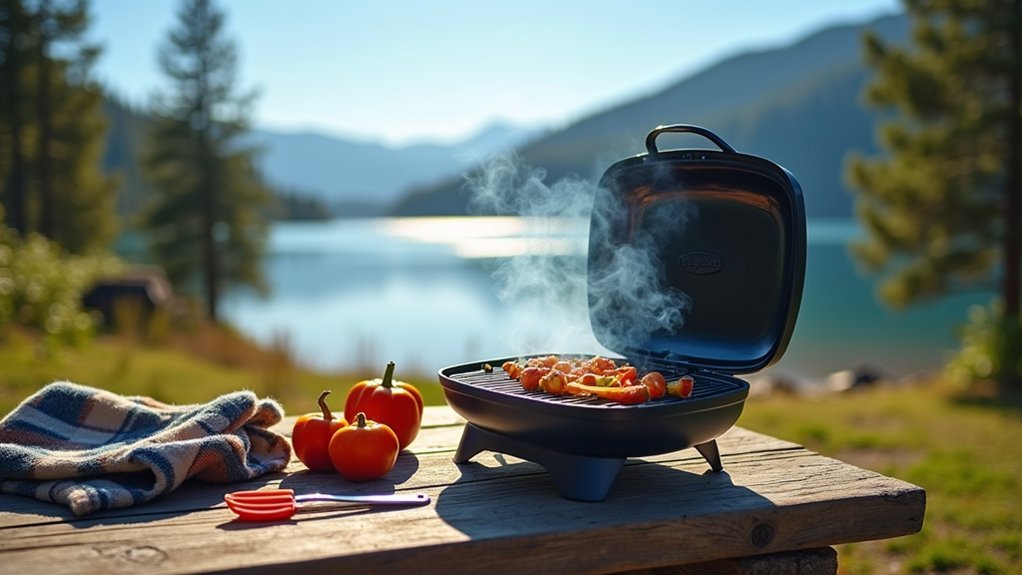

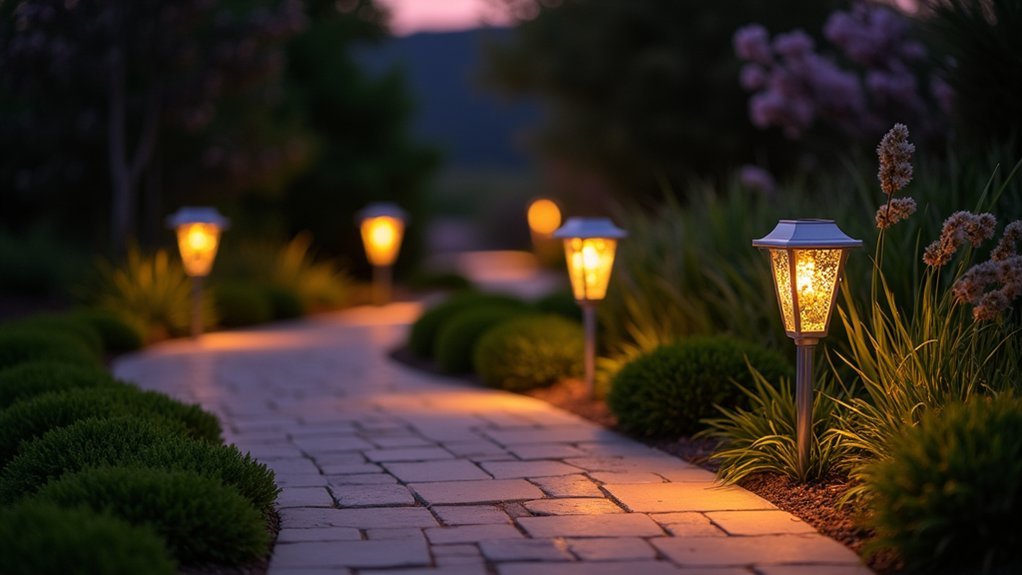
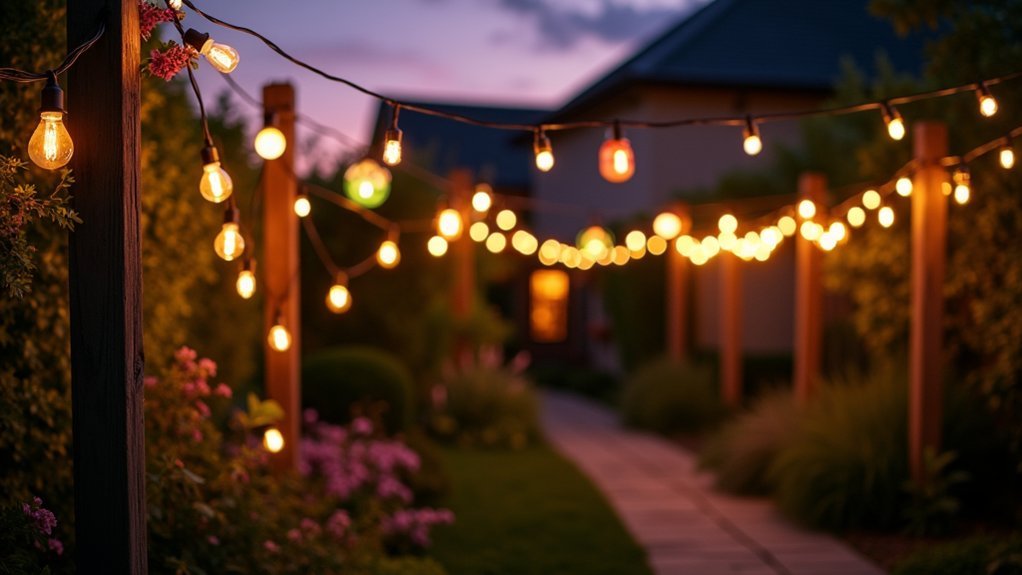
Leave a Reply